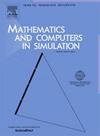Hopf bifurcation in a generalized Goodwin model with delay
IF 4.4
2区 数学
Q1 COMPUTER SCIENCE, INTERDISCIPLINARY APPLICATIONS
引用次数: 0
Abstract
Goodwin’s model is a cornerstone in the study of dynamical systems within macroeconomics, explaining the interaction between employment ratio and wage share in a closed economy. Analogous to predator–prey dynamics in mathematical economics, the Goodwin model, despite its simplicity, effectively captures the periodic behavior of state variables over specific time intervals. By relaxing the initial assumptions, the model can be adapted to account for more complex economic scenarios. In this article, we study a higher-dimensional extension of the Goodwin model that incorporates variable capacity utilization and capital coefficient alongside employment ratio and wage share. In particular instances, the wage share and employment rate equations decouple from the overall system. For these cases, by incorporating a delay effect in the Phillips curve, we demonstrate that while the equilibrium of the generalized system remains stable within certain parameter domains in the absence of delay, the introduction of delay can induce a Hopf bifurcation, leading to periodic oscillations. We analytically derive the critical delay parameter value that destabilizes the equilibrium point via a Hopf bifurcation.
一类时滞广义Goodwin模型的Hopf分岔
古德温的模型是宏观经济学动态系统研究的基石,解释了封闭经济中就业率和工资份额之间的相互作用。与数学经济学中的捕食者-猎物动力学类似,古德温模型尽管简单,但却有效地捕捉了状态变量在特定时间间隔内的周期性行为。通过放宽初始假设,该模型可以适应更复杂的经济情景。在本文中,我们研究了古德温模型的高维扩展,该模型包含了可变的产能利用率和资本系数以及就业率和工资份额。在特殊情况下,工资份额和就业率方程与整个系统脱钩。对于这些情况,通过在Phillips曲线中加入延迟效应,我们证明了在没有延迟的情况下,当广义系统的平衡在某些参数域中保持稳定时,延迟的引入会引起Hopf分岔,导致周期振荡。通过Hopf分岔,解析导出了使平衡点失稳的临界延迟参数值。
本文章由计算机程序翻译,如有差异,请以英文原文为准。
求助全文
约1分钟内获得全文
求助全文
来源期刊

Mathematics and Computers in Simulation
数学-计算机:跨学科应用
CiteScore
8.90
自引率
4.30%
发文量
335
审稿时长
54 days
期刊介绍:
The aim of the journal is to provide an international forum for the dissemination of up-to-date information in the fields of the mathematics and computers, in particular (but not exclusively) as they apply to the dynamics of systems, their simulation and scientific computation in general. Published material ranges from short, concise research papers to more general tutorial articles.
Mathematics and Computers in Simulation, published monthly, is the official organ of IMACS, the International Association for Mathematics and Computers in Simulation (Formerly AICA). This Association, founded in 1955 and legally incorporated in 1956 is a member of FIACC (the Five International Associations Coordinating Committee), together with IFIP, IFAV, IFORS and IMEKO.
Topics covered by the journal include mathematical tools in:
•The foundations of systems modelling
•Numerical analysis and the development of algorithms for simulation
They also include considerations about computer hardware for simulation and about special software and compilers.
The journal also publishes articles concerned with specific applications of modelling and simulation in science and engineering, with relevant applied mathematics, the general philosophy of systems simulation, and their impact on disciplinary and interdisciplinary research.
The journal includes a Book Review section -- and a "News on IMACS" section that contains a Calendar of future Conferences/Events and other information about the Association.
 求助内容:
求助内容: 应助结果提醒方式:
应助结果提醒方式:


